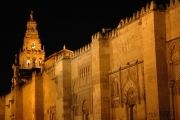Back to Timelines

Abd al-Rahman III Becomes Amir

Abd al-Rahman III Declares Himself Caliph

Abd al-Rahman III declares himself caliph in Córdoba, openly challenging the Abbasids in Baghdad and countering the claim of the Shi’i Fatimids in North Africa. Al-Andalus flourishes, and Córdoba becomes a large, prosperous, and cosmopolitan capital city, according to such visitors as Hroswitha, a Benedictine nun from Germany.
Royal City of Madinat al-Zahra Is Built

The royal city of Madinat al-Zahra is built on the outskirts of Córdoba. The caliph’s large household and numerous government ministries take up residence in the vast palace complex. Workshops produce fine luxury goods, such as silken robes, carved ivory boxes, and colorful ceramics for the upper classes, as well as swords and shields for the army.
Recemundus Is Sent To Normalize Relations With the Holy Roman Emperor

Recemundus, a Mozarabic cleric, is sent by the caliph on a diplomatic mission to the court of Otto I the Great of Germany, to normalize relations with the Holy Roman Emperor, the most powerful Christian ruler in western Europe. Recemundus later authors the Calendar of Córdoba, a valuable compendium of agricultural practices in Al-Andalus. John of Gorze, a monk and diplomat, visits Córdoba on behalf of Otto II a few years later.
Caliph al-Hakam II Continues His Father’s Pattern of Wise Governance

Caliph al-Hakam II continues his father’s pattern of wise governance by supporting scientific and literary activities, funding public works, and expanding agricultural projects. He also makes peace with Christian rulers in the north. Hispani-Roman conversion to Islam reaches its peak. In light of Córdoba’s growing population, which exceeds 500,000, al-Hakam enlarges the Great Mosque.
Fatimids Conquer Egypt and Found Cairo

The Fatimids conquer Egypt and found Cairo as their new capital. Maslama al-Majriti brings Al-Khawarizmi’s algebra and astronomical tables to Al-Andalus. The French monk, Gerbert of Aurillac — having studied mathematics in Barcelona, Córdoba and Seville — tutors Otto II, the future Holy Roman Emperor. In 999, Gerbert is elected Pope and takes the name Sylvester II.
Muhammad Ibn Abi Amir (Al-Mansur) Becomes the Regent of Caliph Hisham II

Muhammad Ibn Abi Amir (Al-Mansur), an ambitious palace official, becomes the regent of 11-year-old Caliph Hisham II, son of al-Hakam. Al-Mansur leads a series of military campaigns against Christian fortresses and towns for two decades, relying on new Berber forces from North Africa. In 987, he attacks the pilgrimage town of Santiago de Compostela, enhancing his fearsome reputation among the Christian inhabitants in the north.
Sancho III of Navarre Inflicts Major Losses On the Muslims

Sancho III of Navarre inflicts major losses on the Muslims. He then gains control of Aragon and Castile, uniting the three kingdoms for a brief period before granting them to each of his sons. Al-Mansur dies from a battle wound.
Conflict Erupts

Conflict erupts between newly arrived Berber troops from North Africa and the urban population of Córdoba, leading to the death of Caliph Hisham II and the sacking of Madinat al-Zahra. Anarchy reigns, and power is divided among Arab elites, Berber mercenaries, muwallads, and Slav converts to Islam, who served the caliph. The eminent surgeon, al-Zahrawi, dies. He authored a 30-volume work on medicine, which remained important in its Latin form for over five centuries.
Zawi ibn Ziri Makes Granada His Capital

The Berber chief, Zawi ibn Ziri, makes Granada his capital. The Slav Mujahid, al-Amiri, rules in Almería, a key southern port city. The North African Shi’i Berbers, the Ibn Hammud brothers, attempt to wrest the caliphate in Córdoba from Umayyad princes. The qadi (chief judge) of Seville, Muhammad ibn Abbad, declares independence from Córdoba.




